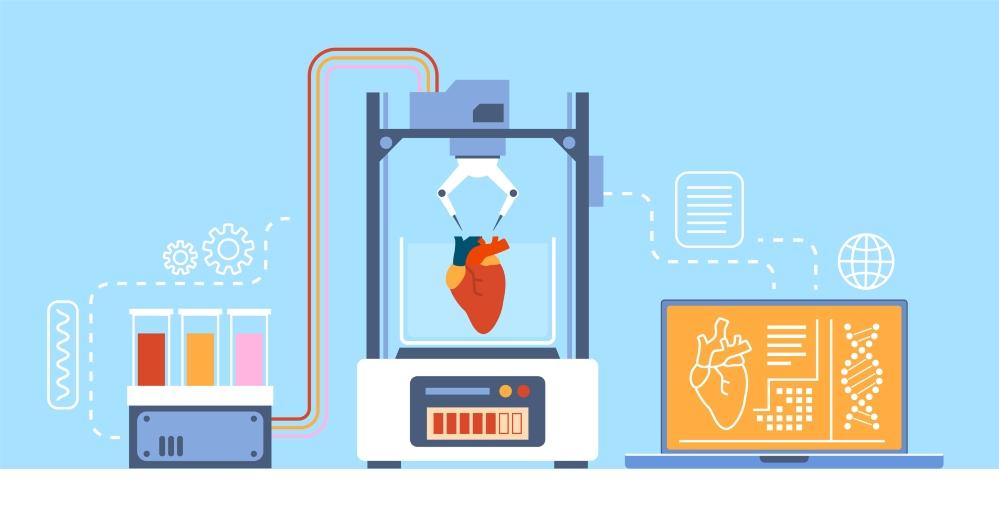- FMA
- The Fabricator
- FABTECH
- Canadian Metalworking
Our Publications
Categories
- Additive Manufacturing
- Aluminum Welding
- Arc Welding
- Assembly and Joining
- Automation and Robotics
- Bending and Forming
- Consumables
- Cutting and Weld Prep
- Electric Vehicles
- En Español
- Finishing
- Hydroforming
- Laser Cutting
- Laser Welding
- Machining
- Manufacturing Software
- Materials Handling
- Metals/Materials
- Oxyfuel Cutting
- Plasma Cutting
- Power Tools
- Punching and Other Holemaking
- Roll Forming
- Safety
- Sawing
- Shearing
- Shop Management
- Testing and Measuring
- Tube and Pipe Fabrication
- Tube and Pipe Production
- Waterjet Cutting
Industry Directory
Webcasts
Podcasts
FAB 40
Advertise
Subscribe
Account Login
Search
Blood, brains, and burgers: Are 3D printers Santa Claus machines?
A forward-looking writer believes that one day naturally occurring items will be 3D-printed
- By Kip Hanson
- November 5, 2021
Full disclosure: The title is not mine. At least, not all of it. The three B-words up front came from the mind of Australian writer Rich Haridy over at New Atlas, a science and technology newsletter that covers cool topics as such tiny houses, quantum computing, drones, and robotics.
And, yes, 3D printing comes up from time to time. Subscriptions are free, but I ponied up the $19 for a premium membership. (No ads.)
Haridy brings up a couple of topics I’ve covered previously in The Additive Report. One is about 3D-printed food, and the other looks at additively manufactured human body parts.
Haridy suggests that these and many other naturally occurring items will one day be grown in laboratories, using devices that some refer to as “Santa Claus Machines” or Star Trek-inspired “replicators.” He even goes so far as to suggest that we’ll be growing our tables, chairs, and other wooden furniture. (Sorry, IKEA.)
It got me thinking. Earth is the ultimate 3D printer. Nearly all of the items discussed in his article—meat, dairy, diamonds, wood, blood, organs—are created through natural processes, meaning Mother Nature or God (whichever of Her 9 billion names you prefer) produced them additively. The only item on Haridy’s list that does not occur naturally is the automobile, although he closes by saying that some ambitious people at Mercedes-Benz are working to one day “grow” cars from genetically engineered seeds. Crazy, right?
Granted, we’re a long ways from Santa Claus Machines. For starters, all 3D printers today require feedstock that does not occur naturally, whether it’s powder, resin, bound metal rods, or plastic fishing line. Each of these is made by humans using processes that are far less elegant than those employed by Mother Earth or the laboratory scientists who are apparently making significant progress in bioprinting.
Nor does any 3D printer currently have the resolution, accuracy, and delicate touch necessary to coax cellular materials into forming advanced, possible-living structures. Not yet.
Anyway, check out the article. Whatever your thoughts on cultured meat, pluripotent stem cells, and bioengineered skim milk, you’ll learn about some of the really neat stuff going on out there.
About the Author

Kip Hanson
About the Publication
- Podcasting
- Podcast:
- The Fabricator Podcast
- Published:
- 04/16/2024
- Running Time:
- 63:29
In this episode of The Fabricator Podcast, Caleb Chamberlain, co-founder and CEO of OSH Cut, discusses his company’s...
- Trending Articles
- Industry Events
16th Annual Safety Conference
- April 30 - May 1, 2024
- Elgin,
Pipe and Tube Conference
- May 21 - 22, 2024
- Omaha, NE
World-Class Roll Forming Workshop
- June 5 - 6, 2024
- Louisville, KY
Advanced Laser Application Workshop
- June 25 - 27, 2024
- Novi, MI



























